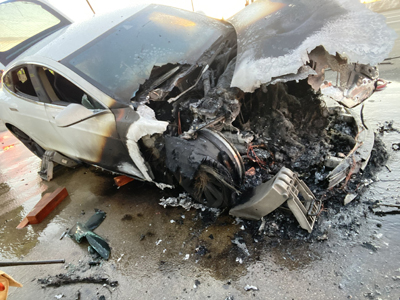According to Metro Fire of Sacramento, a Tesla Model S electric sedan caught fire unexpectedly while it was moving at highway speeds in California.
Thankfully, no one was injured by the blaze, but it was difficult for the trained crews to extinguish it.
While EV fires are few and far between compared to gas car fires, they tend to get a lot of attention, and for good reason. EV fires burn extremely hot and often turn into huge blazes rather quickly, sometimes engulfing the cars in flames. Meanwhile, the fire is difficult to put out, and it can reignite over and over. There have even been cases of EVs seemingly reigniting days after an accident, while the cars are parked at a junkyard or investigation site.
Gas car fires happen every day, so they're not necessarily at the top of the media's coverage radar. However, there are also many more gas cars on the road than there are EVs, so it's still too soon to know how EV fires and gas car fires would stack up if the number of vehicles was even.
It can be argued gasoline is much more volatile and immediately flammable than the lithium-ion batteries in EVs, which are also in laptops, smartphones, tablets and other devices. But the batteries have certain properties that can cause unique issues, which require firefighters to be specially trained to deal with them.
The Sacramento Fire Department tweeted it took about 6,000 gallons of water to put out the Tesla Model S fire. The responders had to lift the EV up to get as much water as possible to douse the battery since it continued to reignite as the work progressed.
According to autoblog, Tesla recommends the use of "large amounts of water to cool the battery." Several people responded to the fire department's tweets wondering if a different method should or could have been used to put out the EV fire more quickly, without the use of so much water.
However, Tesla's guide says:
"It can take between approximately 3,000-8,000 gallons of water, applied directly to the battery, to fully extinguish and cool down a battery fire; always establish or request additional water supply early. If safety permits, lift or tilt the vehicle for more direct access to the battery."
The trained firefighters did precisely as Tesla suggests, and were eventually successful. However, as more and more EVs take to our roadways, it's imperative teams of first responders have special training to ensure the best results in the case of a battery fire.














